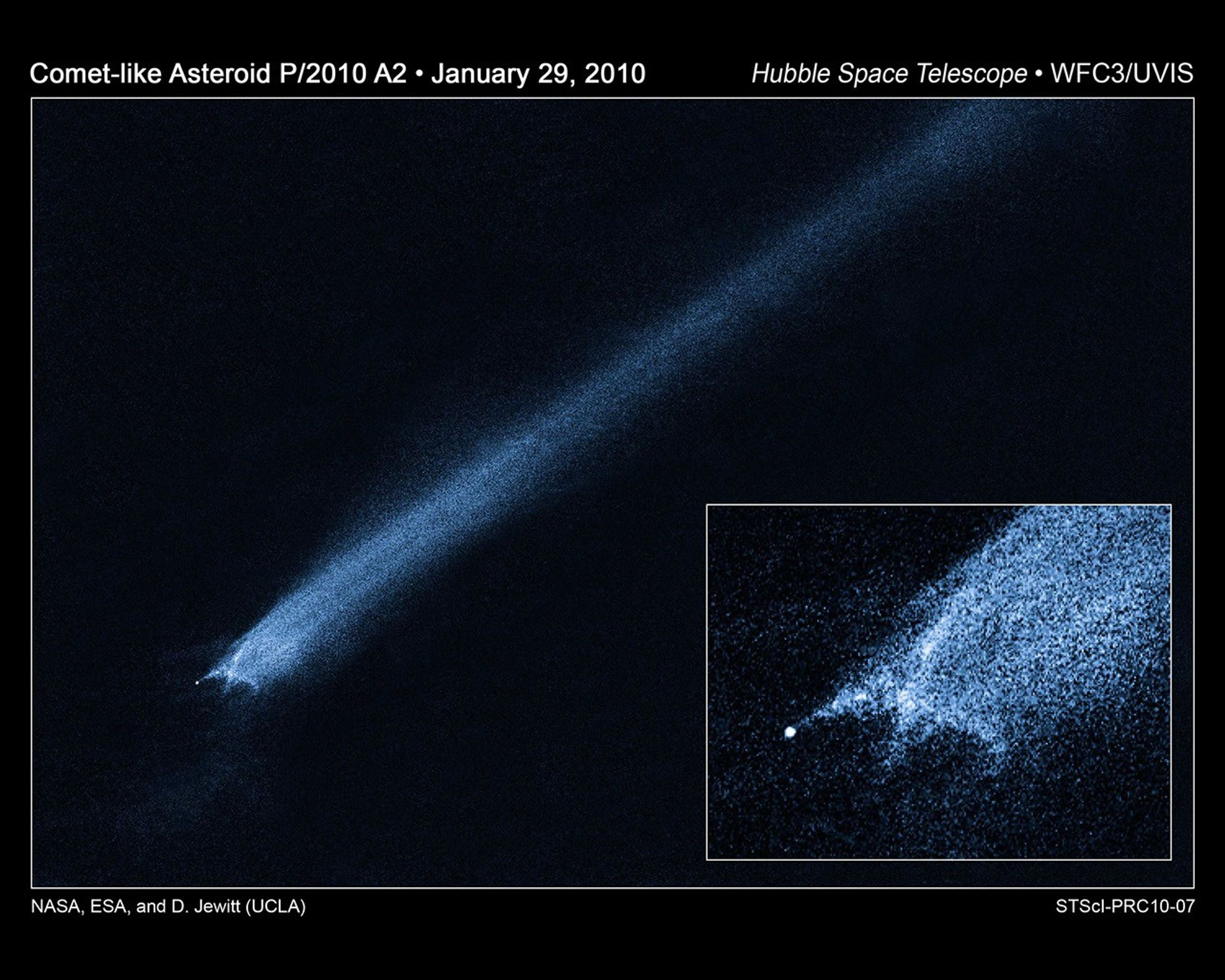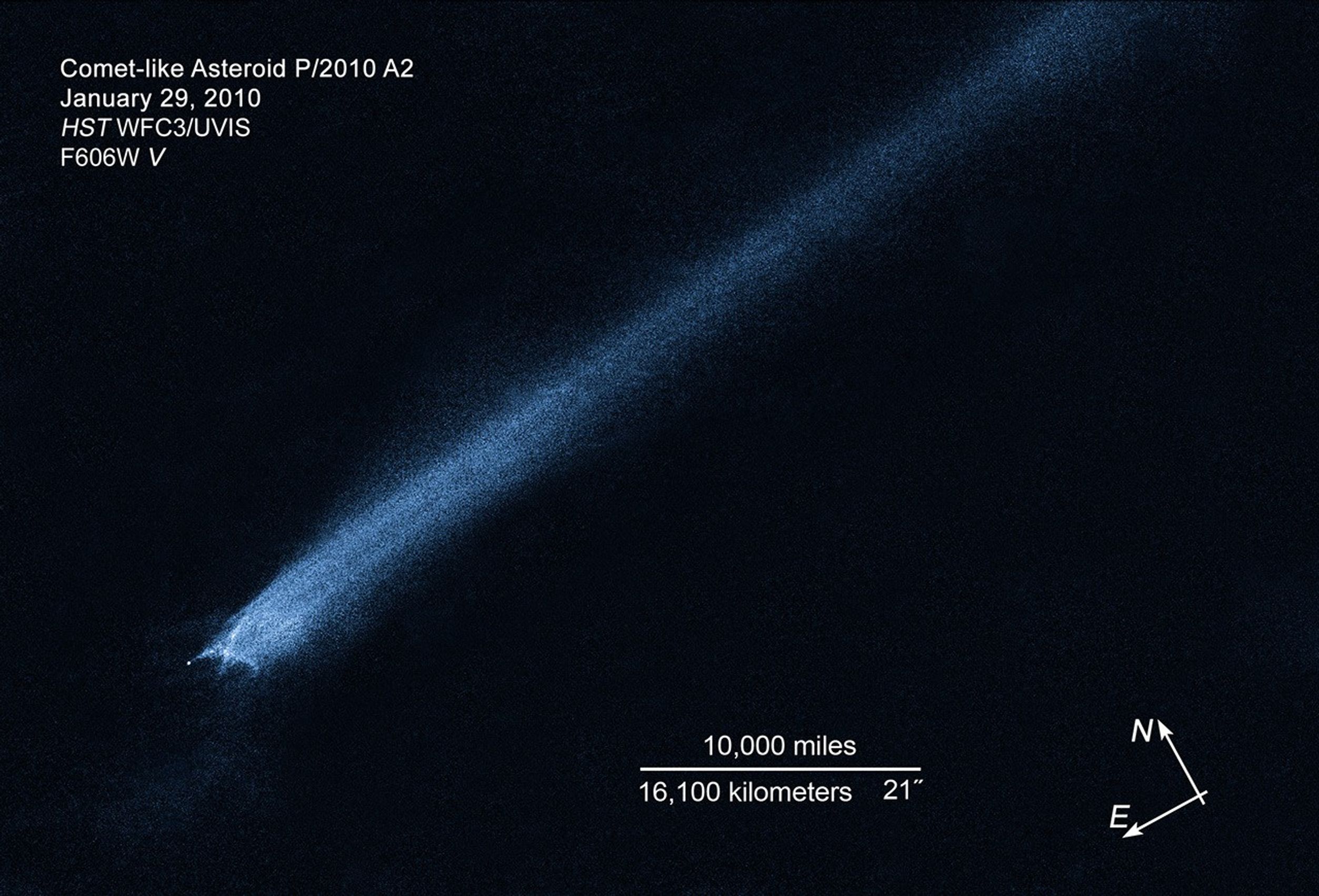1 min read
Hubble Views of Comet-like Asteroid P/2010 A2

This is a NASA Hubble Space Telescope picture of a comet-like object called P/2010 A2, which was first discovered by the LINEAR (Lincoln Near-Earth Asteroid Research program) sky survey on January 6. The object appears so unusual in ground-based telescopic images that discretionary time on Hubble was used to take a close-up look. This picture, from the January 29 observation, shows a bizarre X-pattern of filamentary structures near the point-like nucleus of the object and trailing streamers of dust.
The inset picture shows a complex structure that suggests the object is not a comet but instead the product of a head-on collision between two asteroids traveling five times faster than a rifle bullet (5 kilometers per second). Astronomers have long thought that the asteroid belt is being ground down through collisions, but such a smashup has never before been seen.
The filaments are made of dust and gravel, presumably recently thrown out of the 460-foot-diameter nucleus. Some of the filaments are swept back by radiation pressure from sunlight to create straight dust streaks. Embedded in the filaments are co-moving blobs of dust that likely originate from tiny unseen parent bodies. An impact origin would also be consistent with the absence of gas in spectra recorded using ground-based telescopes.
At the time of the Hubble observations, the object was approximately 180 million miles (300 million km) from the Sun and 90 million miles (140 million km) from Earth. The Hubble images were recorded with the new Wide Field Camera 3 (WFC3). The image was taken in visible light. The color in the image is not what the human eye would see. A blue color map was added to bring out subtle details.
About the Object
- DistanceDistanceThe physical distance from Earth to the astronomical object. Distances within our solar system are usually measured in Astronomical Units (AU). Distances between stars are usually measured in light-years. Interstellar distances can also be measured in parsecs.100 million miles (160 million km) from Earth.
About the Data
- Data DescriptionData DescriptionProposal: A description of the observations, their scientific justification, and the links to the data available in the science archive.
Science Team: The astronomers who planned the observations and analyzed the data. "PI" refers to the Principal Investigator.The image was created from Hubble data from proposal 12053: D. Jewitt (UCLA), H. Weaver (JPL/APL), M. Drahus (UCLA), and M. Mutchler (STScI). - InstrumentInstrumentThe science instrument used to produce the data.HST>WFC3/UVIS
- Exposure DatesExposure DatesThe date(s) that the telescope made its observations and the total exposure time.January 25 and 29, 2010
- FiltersFiltersThe camera filters that were used in the science observations.F606W (V)
- Object NameObject NameA name or catalog number that astronomers use to identify an astronomical object.Comet-like Asteroid P/2010 A2
- Object DescriptionObject DescriptionThe type of astronomical object.Asteroid Belt Impact Object
- Release DateFebruary 2, 2010
- Science ReleaseSuspected Asteroid Collision Leaves Odd X-Pattern of Trailing Debris
- Credit

This image was originally black and white and recorded only overall brightness. These brightness values were translated into a range of bluish hues. Such color "maps" can be useful in helping to distinguish subtly varying brightness in an image.

Share
Details
Claire Andreoli
NASA’s Goddard Space Flight Center
Greenbelt, Maryland
claire.andreoli@nasa.gov































